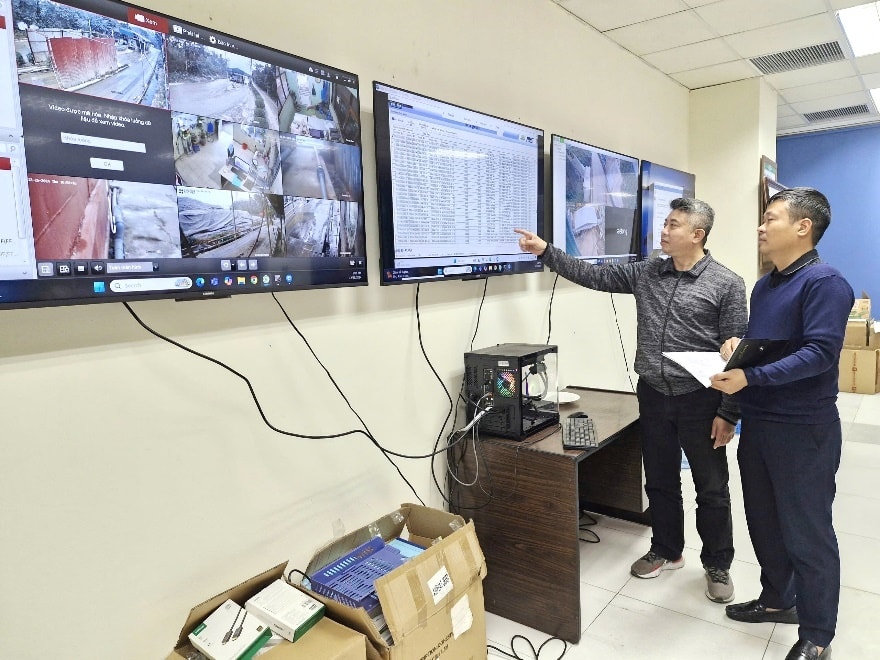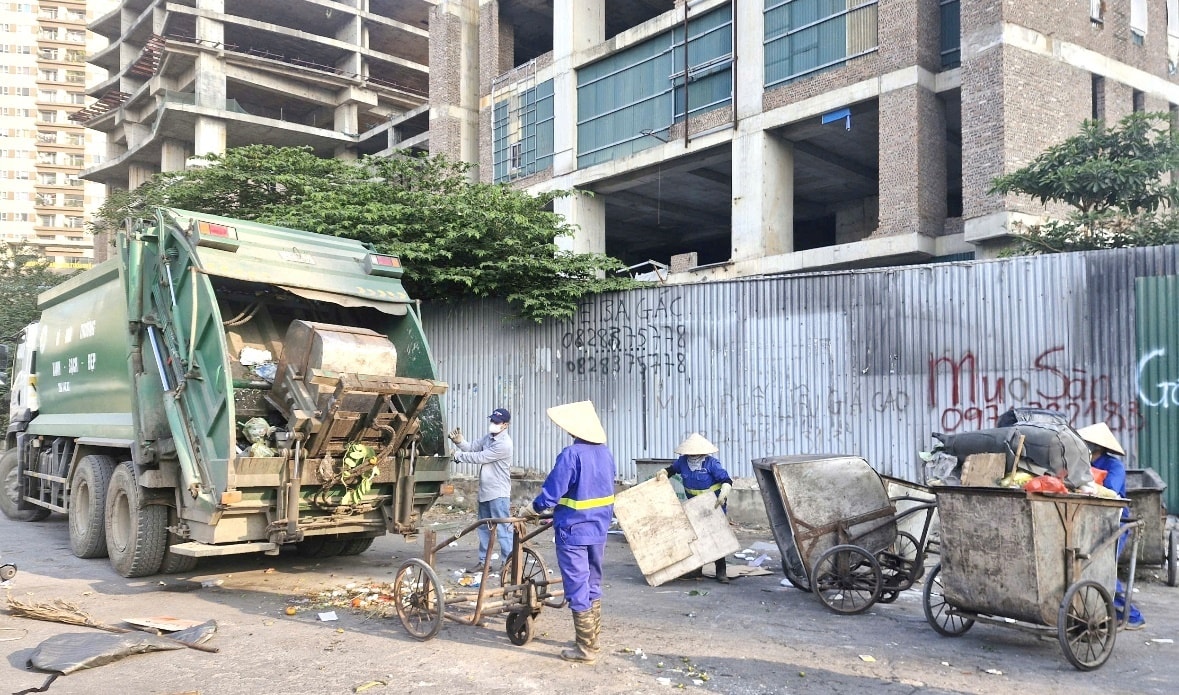According to estimates, the total amount of household waste generated in Hanoi and transported to centralized waste treatment facilities is approximately 6,800 to 7,500 tons per day.
To address the growing waste management challenge, the city has implemented a range of solutions. These include attracting investment and promoting public-private partnerships to develop modern waste treatment projects.
Currently, the collection and transportation of daily waste reaches 100% in urban districts, while suburban districts and towns maintain a collection rate of 95-100%.

Officials supervise the process of waste management through monitors.
The People's Committees of Hoan Kiem, Ba Dinh, Dong Da, Hai Ba Trung, and Nam Tu Liem districts have successfully piloted waste sorting at the source, yielding positive results. More than 380.1 tons of recyclable waste and nearly 160 tons of bulky waste have been collected. In addition, hazardous waste is being sorted and brought to designated collection points.
As a result, the amount of waste transported to the city's centralized treatment facilities has gradually decreased, with Hoan Kiem District alone reducing waste by 2-2.8%. Overall, the city has managed solid waste reception effectively, preventing waste accumulation in residential areas.
However, during the New Year and Lunar New Year periods, rising consumer demand leads to a significant increase in solid waste from shopping and home cleaning. This surge presents a major challenge for the city in terms of waste collection, transportation, and treatment.
The Hanoi Center for Environmental and Technical Resources predicts a sharp rise in waste volume during the holiday season. In previous years, waste generation during the Lunar New Year increased by about 40% compared to normal days. This year, waste volume is expected to surge significantly between February 1 and February 7, 2025, with peak levels on February 7 reaching 9,000 tons per day—150-200% higher than normal.
The increase in solid waste during peak periods places significant pressure not only on collection units but also on the city's centralized waste treatment facilities. At the Nam Son Waste Treatment Complex in Soc Son District, the average daily waste intake is currently around 6,400 tons. However, during the New Year period, from December 31, 2024, to January 3, 2025, the daily intake is expected to rise to 6,800 tons.
The situation will be even more challenging during the Lunar New Year, with daily waste intake projected to reach 8,000 tons from February 19 to February 28, 2025.
At the Xuan Son Waste Treatment Facility in Son Tay Town and Ba Vi District, the average daily intake is about 770 tons. However, during the New Year celebrations, this will increase to approximately 850 tons per day. During the peak 10-day period from February 19 to February 28, daily intake is expected to range from 800 to 1,000 tons.

Waste collection process.
To ensure a clean and festive atmosphere, waste management, collection, and processing require close coordination among government agencies and active community participation. Recognizing the urgency of this issue, the Department of Natural Resources and Environment has proactively implemented early plans to meet the city's sanitation needs during the New Year and Lunar New Year in 2025.
In addition to advising the municipal People's Committee to issue Plan No. 359/KH-UBND on December 10, 2024, which promotes the "bright, green, clean, and beautiful" campaign, and Plan No. 366/KH-UBND on December 13, 2024, aimed at improving waste collection and sanitation in Hanoi's four historic districts, the department has also issued several directives in December. These directives urge districts, towns, and relevant agencies to maintain environmental sanitation and ensure the smooth operation of waste treatment during the holiday season.
Under the department's directive, the Hanoi Center for Environmental and Technical Resources has developed specific and detailed plans to ensure uninterrupted waste reception at the city's centralized waste treatment facilities during the New Year and Lunar New Year.
Nguyen Tan Cuong, Director of the center, stated that meetings have been held with relevant units and waste treatment facility operators to ensure seamless operations at the Xuan Son and Nam Son waste treatment sites. Measures include increasing equipment, chemical supplies, and manpower, with 100% of staff working around the clock to ensure continuous and safe waste collection and treatment. The center is also coordinating with local authorities to maintain workplace safety, security, traffic flow, and fire prevention measures.
Additionally, contingency plans have been developed to address any sudden surges in waste at sanitary landfill sites. If landfill capacity is compromised, the center will instruct the Soc Son Waste-to-Energy Plant to temporarily store excess waste to prevent any environmental issues.
Trinh Minh Tuan, Deputy Head of the Solid Waste Management Supervision Division at the Hanoi Center for Environmental and Technical Resources, emphasized that monitoring at waste treatment facilities is especially critical during the holiday season, as household and food waste will likely increase significantly. As such, the center has meticulously prepared plans for waste reception and workforce deployment.
Following assigned responsibilities, the division has stationed personnel around the clock to monitor waste management operations, ensuring that waste is not left uncollected or causes environmental hazards. The center has also set up task forces for regular and surprise inspections at waste treatment facilities to track waste volumes, evaluate management efficiency, and prevent any incidents. Reports indicate that waste management companies operating at Xuan Son and Nam Son facilities have devised detailed plans to maintain seamless waste reception and treatment throughout the holiday season.